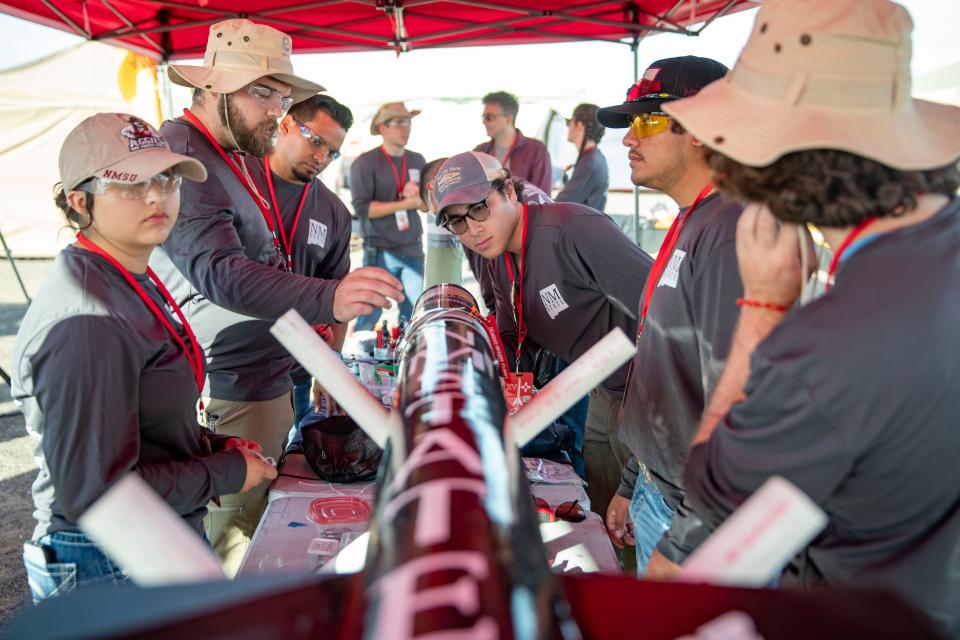Atomic Aggies claim Spaceport America Chile Cup
LAS CRUCES – Eight members of New Mexico State University's rocketry team gathered in front of Hadley Hall Tuesday for a victory photograph with their rocket, Rising Phoenix, and the trophy they won at this summer's Spaceport America Cup.
The international rocket competition for higher education institutions was held in Las Cruces and at Spaceport America in Sierra County last month, but awards were delayed for three weeks this year due to technical problems at the launch area. Awards in various categories based on rocket design, fuel and payloads were announced in a virtual ceremony on July 16.
That was when NMSU's team, the Atomic Aggies, learned they had claimed the competition's Chile Cup, an overall prize for teams based in New Mexico and Texas. The trophy resembles the arc-shaped sculpture that stands in front of the spaceport's main entrance, with the addition of a pair of chile peppers (red and green, naturally).
NMSU's first entry at the Cup in 2018 blew up shortly after leaving the launch rail. This year, however, their rocket reached the target apogee of 10,000 feet with a stable ascent, the glider on board released and extended its wings as planned and the rocket deployed air brakes as well as a parachute to guide its descent. Both the rocket and glider were recovered undamaged. The mission narrowly missed placing near the top in multiple categories, according to the event's final scores.

The performance was strong enough to wrest the team's first Chile Cup from rival teams at the University of New Mexico, New Mexico Tech and the University of Texas at El Paso.
With the group photos done, the team walked Rising Phoenix carefully across the lawn to the team's shop in Jett Hall. The space consists of two small rooms packed with various component pieces, motor parts, construction materials and storage.
The team's new lead engineer, Ricardo Olivas, said 90 percent of the components were designed and constructed by the students themselves. He said NMSU's Aggie Innovation Space, a student-managed shop located in the engineering complex, was a major asset with tools including laser and water jet cutters and computer guided machining equipment. "It's one of the more modern shops in the state," he said.
Asked what lessons they learned from their flight, team members said at first they would rethink wearing black jerseys in the desert sun. As far as engineering is concerned, Olivas said the mission demonstrated that their systems "pretty much all worked as they should. So now it's just pushing them to the limits, to make sure that we refine them and they're fine tuned to get us closer to 10,000 feet."
Rising Phoenix, the product of a full year of work with input from as many as 40 students, exceeded its calculated apogee by 36 feet, Olivas explained, a margin of error below 1 percent, while the payload worked "flawlessly."
Building on that performance will also require a recruiting effort, as the Atomic Aggies were "senior-heavy" this year, losing much of their talent to graduation while its elder members are, in turn, now entering their final year.
"We lost a lot of good brains, great minds," Olivas said, "but this new, younger generation is more ambitious, more open to new ideas and crazier ideas."
Not limiting themselves to incoming freshmen, the team has also begun outreach to high school seniors, using college fairs to let them know rocketry is available for them to explore at NMSU as well as other institutions in New Mexico.
Olivas was quick to add: "We're the better rocketry team."
The Intercollegiate Rocket Engineering Competition (IREC) was founded in 2006 by the nonprofit Experimental Sounding Rocket Association, which continues to manage the event. In 2017, it was rebranded as the Spaceport America Cup with New Mexico's purpose-built commercial spaceport hosting the contest.
The spaceport reported more than 1,300 participants participated in June, from 95 higher education institutions in 16 countries.
Among this year's sponsors were aerospace companies that look to the event to meet and recruit talent, including main sponsor Sierra Space, spaceport anchor tenant Virgin Galactic and Blue Origin among others.
The intersection between the competition and careers in engineering and aerospace are clear enough to the team. Tori Hoffman, a team member entering her senior year, worked as a business intern with Virgin Galactic this summer, and their team leader at the Cup, Scott Komar, graduated last year and has already begun his aerospace career with a position at SpaceX.
Algernon D'Ammassa can be reached at 575-541-5451, adammassa@lcsun-news.com or @AlgernonWrites on Twitter.
This article originally appeared on Las Cruces Sun-News: Atomic Aggies claim Spaceport America Chile Cup

